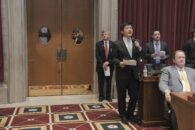By John Lee
Tax Simple Center
Tax Simple Center
Before his resignation, Governor Greitens managed to help job creators—and their employees—one last time. He recently signed into law SB 884, which slashed Missouri’s corporate tax rate from 6.25 percent to an even more pro-growth four percent. The new rate will go into effect in 2020, boosting employers’ tax savings and encouraging them to ramp up investment.
In the words of bill sponsor Sen. Andrew Koenig (R-Manchester): “I believe this will make our state more competitive, giving us the second lowest rate in the country.”
He’s right. When job creators are allowed to retain more of their income, they use it to not only boost investment, but also reward employees with all sorts of benefits.
We’re seeing it at the national level. Since the passage of the Tax Cuts and Jobs Act, more than 600 U.S. employers have given out pay raises, 401(k) increases, bonuses, and other employee benefits. From large corporations like Apple and Wal-Mart to hundreds of small businesses, job creators are putting their tax savings to work—benefitting millions of working Americans.
In Missouri, Rogersville-based Mid-AM Metal Forming provided all 140 of its employees with cash bonuses. In addition to awarding $1,000 bonuses, Raytown’s Dynamic Fastener will open a paint shop, buy new equipment, and hire more workers. Kansas City Power and Light, meanwhile, plans to pass on $100 million in annual tax savings to consumers in the form of utility rate reductions.
Not surprisingly, the White House now plans to pursue a second round of tax reform, which would make last year’s tax cuts permanent and extend tax relief beyond 2025. Given that 90 percent of American wage-earners will see greater take-home pay because of federal tax cuts, why not reward them even more?
But as lawmakers here and in Washington, D.C. continue to slash rates, they shouldn’t forget tax simplification. An overwhelming majority of Americans (90 percent) believe the individual tax code is complex, making it difficult for them to file their taxes cheaply and efficiently.
As an expert on federal and state tax codes, I understand the problem better than most. Existing tax systems typically have multiple tax brackets, tax schedules, tax tables, withholding tables, and computations, which are complicated and time-consuming. There are generally two systems: Tax rate schedules with lengthy tax withholding tables (for tax estimations) and tax tables (for tax returns) with up to 35 pages. The two systems only add tax complexity and cost. This is the case in most states, including Missouri.
The solution to the problem is a transition to the often-ignored linear and gradual (LG) tax rate system. Among other reforms, the LG system would match, combine, and simplify the existing two systems into a consolidated system that is less than a page long. This consolidation could save a state like Missouri anywhere from $100 million to $600 million annually, while the federal government could see billions of dollars in savings.
Missouri currently has 10 tax brackets, which can be reduced to two with compatible results. Many employees with standard deductions and non-complex tax situations may also have the option to not file tax returns with tax withholding reports, which can reduce filing time and costs.
The bottom line is this: We need lower rates (and a balanced budget), but also a simplified tax system. Tax simplification would save the government millions of dollars and the rest of us plenty of headaches.
John Lee is the founder of Tax Simple Center in Kansas City, MO.
In the words of bill sponsor Sen. Andrew Koenig (R-Manchester): “I believe this will make our state more competitive, giving us the second lowest rate in the country.”
He’s right. When job creators are allowed to retain more of their income, they use it to not only boost investment, but also reward employees with all sorts of benefits.
We’re seeing it at the national level. Since the passage of the Tax Cuts and Jobs Act, more than 600 U.S. employers have given out pay raises, 401(k) increases, bonuses, and other employee benefits. From large corporations like Apple and Wal-Mart to hundreds of small businesses, job creators are putting their tax savings to work—benefitting millions of working Americans.
In Missouri, Rogersville-based Mid-AM Metal Forming provided all 140 of its employees with cash bonuses. In addition to awarding $1,000 bonuses, Raytown’s Dynamic Fastener will open a paint shop, buy new equipment, and hire more workers. Kansas City Power and Light, meanwhile, plans to pass on $100 million in annual tax savings to consumers in the form of utility rate reductions.
Not surprisingly, the White House now plans to pursue a second round of tax reform, which would make last year’s tax cuts permanent and extend tax relief beyond 2025. Given that 90 percent of American wage-earners will see greater take-home pay because of federal tax cuts, why not reward them even more?
But as lawmakers here and in Washington, D.C. continue to slash rates, they shouldn’t forget tax simplification. An overwhelming majority of Americans (90 percent) believe the individual tax code is complex, making it difficult for them to file their taxes cheaply and efficiently.
As an expert on federal and state tax codes, I understand the problem better than most. Existing tax systems typically have multiple tax brackets, tax schedules, tax tables, withholding tables, and computations, which are complicated and time-consuming. There are generally two systems: Tax rate schedules with lengthy tax withholding tables (for tax estimations) and tax tables (for tax returns) with up to 35 pages. The two systems only add tax complexity and cost. This is the case in most states, including Missouri.
The solution to the problem is a transition to the often-ignored linear and gradual (LG) tax rate system. Among other reforms, the LG system would match, combine, and simplify the existing two systems into a consolidated system that is less than a page long. This consolidation could save a state like Missouri anywhere from $100 million to $600 million annually, while the federal government could see billions of dollars in savings.
Missouri currently has 10 tax brackets, which can be reduced to two with compatible results. Many employees with standard deductions and non-complex tax situations may also have the option to not file tax returns with tax withholding reports, which can reduce filing time and costs.
The bottom line is this: We need lower rates (and a balanced budget), but also a simplified tax system. Tax simplification would save the government millions of dollars and the rest of us plenty of headaches.
John Lee is the founder of Tax Simple Center in Kansas City, MO.





